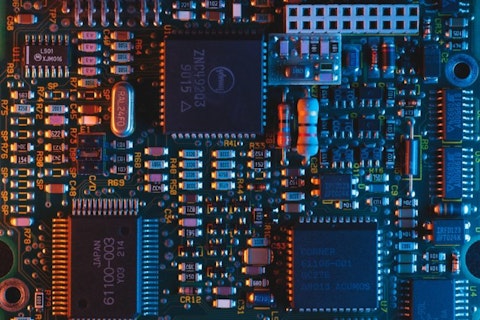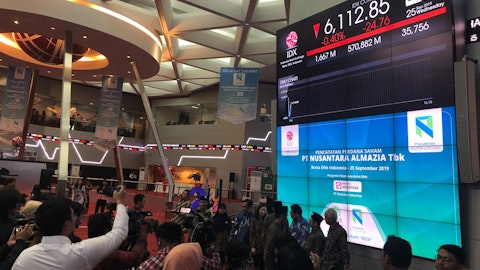Advanced Micro Devices, Inc. (NASDAQ:AMD) Q4 2022 Earnings Call Transcript January 31, 2023
Operator: Hello, and welcome to the AMD Fiscal Fourth Quarter and Full Year 2022 Financial Results Conference Call and Webcast. As a reminder, this conference is being recorded. It’s now my pleasure to turn the call over to Ruth Cotter. Please go ahead, Ruth.
Ruth Cotter: Thank you, and welcome to AMD’s fourth quarter and fiscal year-end 2022 financial results conference call. By now, you should have had the opportunity to review a copy of our earnings press release and accompanying slideware. If you’ve not reviewed these documents, they can be found on the Investor Relations page of amd.com. We will refer primarily to non-GAAP financial measures during this call. The full non-GAAP to GAAP reconciliations are available in today’s press release and slides posted on our website. Participants in today’s conference call are Dr. Lisa Su, our Chair and Chief Executive Officer; Jean Hu, our Executive Vice President, Chief Financial Officer and Treasurer; and Devinder Kumar, our Executive Vice President.
This is a live call and will be replayed via webcast on our website. Before we begin, I would like to note that Mark Papermaster, Chief Technology Officer and Executive Vice President, Technology and Engineering, will attend the Morgan Stanley Technology, Media and Telecom Conference on Monday, March 6. And our first quarter 2023 quiet time is expected to begin at the close of business on Friday, March 17. Today’s discussion contains forward-looking statements based on current beliefs, assumptions and expectations speak only as of today and as such, involve risks and uncertainties that could actually cause results to differ materially from our current expectations. Please refer to the cautionary statement in our press release for more information on factors that could cause actual results to differ materially.
Now with that, I’ll hand the call over to Lisa. Lisa?
Lisa Su: Thank you, Ruth, and good afternoon to all those listening in today. Before discussing our financial results, I wanted to make a few comments about our CFO transition. I’d like to start by thanking Devinder for all of his contributions to AMD over the last 39 years. During his tenure as CFO, we built a strong financial foundation that has enabled AMD’s significant growth and success. On a personal note, his partnership and expertise have been invaluable to me. I know I speak for all of AMD when I say we appreciate all he has done for the company and wish him the best in his upcoming retirement. I also want to welcome our new EVP and CFO, Jean Hu, to our first AMD earnings call since joining us earlier this month. Jean’s more than 14 years of public company CFO experience and proven track record of financial leadership make her an excellent addition to our team.
I look forward to working closely with her as we continue to transform and scale our business. Now turning to the business results. 2022 was a strong year for AMD as we navigated the challenging macro environment to deliver best-in-class growth and record profitability driven by our Embedded and Data Center segments. We also transformed the company. We accelerated our Data Center business and closed our strategic acquisitions of Xilinx and Pensando, significantly diversifying our business and strengthening our financial model as our Data Center, Embedded product sales grew from $3.9 billion in 2021 to $10.6 billion in 2022. Looking at our financial results. Fourth quarter revenue increased 16% year-over-year to $5.6 billion, driven by significant growth in our Embedded and Data Center segments which accounted for more than 50% of overall revenue in the quarter.
On a full year basis, we grew annual revenue 44% to $23.6 billion. We set annual records for revenue, gross margin and profitability driven largely by a 64% increase in our Data Center segment revenue and the strong performance of our Embedded segment following our Xilinx acquisition. Turning to the fourth quarter business results, starting with our Data Center segment. Revenue increased 42% year-over-year to $1.7 billion, led by increased adoption of our EPYC processors by cloud providers. In cloud, sales to North American hyperscalers more than doubled year-over-year as hyperscale customers continued moving more of their internal workloads and external instances to EPYC processors. EPYC processors now power more than 600 publicly available instances globally following the launches of new AMD-based instances from AWS, Microsoft and others in the quarter.
In Enterprise, revenue declined year-over-year as demand slowed based on the macro environment. Against this backdrop, we continue expanding our pipeline and closed a number of new wins in the fourth quarter with Fortune 500 financial services, automotive, technology, energy and aerospace companies. In HPC, growing EPYC processor adoption was highlighted by the number of AMD-powered supercomputers on the latest Top 500 list increasing by 38% year-over-year. AMD now powers more than 100 of the world’s fastest supercomputers and 15 of the top 20 most energy-efficient supercomputers in the world. To build our Data Center leadership, we launched our fourth gen EPYC processors this past November that deliver up to 2x faster performance in cloud, enterprise and HPC applications, and are up to 80% more energy efficient than the competition’s most recently announced offerings.
We are seeing very strong customer pull for fourth-gen EPYC CPUs, which complement our third-gen offerings with additional performance and capabilities. Initial cloud deployments are going very well, and we expect to ramp both internal workloads and public instances throughout 2023. For Enterprise, there are more than 140 fourth-gen EPYC platforms in development from HPE, Dell, Lenovo, Super Micro and others, an increase of 40% compared to the prior generation. Now looking at our broader Data Center portfolio. We had record sales of our Xilinx Data Center and networking products in the quarter, led by strong demand from financial services companies for our newly launched Alveo X3 series boards, optimized for low latency trading. Sales of our Pensando DPUs also ramped significantly from the prior quarter, driven by supply chain improvements and continued demand.
We are very pleased with the customer reception of the Pensando technology with good long-term growth opportunities as DPUs become a standard component in the next generation of cloud and enterprise data centers. Data center GPU sales were down significantly from a year ago when we had shipments supporting the build-out of multiple Instinct MI250 accelerator supercomputer wins. In January, we previewed our next-generation MI300 accelerator that will be used for large model AI applications in cloud data centers and has been selected to power the 2-plus exaflop El Capitan exascale supercomputer at Lawrence Livermore National Laboratories. MI300 will be the industry’s first data center chip that combines a CPU, GPU and memory into a single integrated design, delivering 8x more performance and 5x better efficiency for HPC and AI workloads, compared to our MI250 accelerator currently powering the world’s fastest supercomputer.
MI300 is on track to begin sampling to lead customers later this quarter and launch in the second half of 2023. Turning to our Client segment. Revenue declined 51% year-over-year to $903 million. We continue to ship below PC consumption in the fourth quarter as we focused on further reducing downstream inventory. While overall PC demand remains soft, desktop channel sell-through increased sequentially during the holiday season. We launched our latest generation Ryzen 7000 series notebook processors earlier in January, including our Ryzen 7040 CPU series that deliver leadership performance in battery life and are our first processors to feature Ryzen AI, the industry’s only dedicated on-chip AI inference engine in an x86 processor. Ryzen AI is powered by the highly scalable XDNA architecture, which is the first integration of AMD and Xilinx IP, less than a year after closing the acquisition.
We also launched our Ryzen 7045 series CPUs, our first mobile processor based on a triplet design that delivers significantly higher performance than the competition in gaming and content creation applications. We have more than 250 ultrathin gaming and commercial notebook design wins, spanning our full family of Ryzen 7000 series processors on track to launch this year, an increase of 25% year-over-year with the first notebooks planned to go on sale in February. Now turning to our Gaming segment. Revenue declined 7% year-over-year to $1.6 billion as lower gaming graphics sales more than offset higher semi-custom revenue. Semi-Custom SoC revenue grew year-over-year as demand for game consoles remained strong during the holidays. Gaming graphics revenue declined year-over-year as we further reduced desktop GPU downstream channel inventory.
Channel sell-through of our Radeon RX GPUs increased sequentially, and we launched our high-end Radeon 7900 series GPUs to strong demand based on the performance of our new RDNA 3 architecture and 5-nanometer chiplet design. In January, we announced our first RDNA 3 mobile GPUs that have been selected to power new gaming notebooks from Dell Alienware, ASUS and others that are on track to begin shipping in the first half of 2023. Looking at our Embedded segment. Revenue increased significantly year-over-year to a record $1.4 billion. We had record sales across a number of our Embedded markets, including communications, automotive, industrial and healthcare, aerospace and defense, and test and emulation. In communications, we saw particular strength with expanded 5G wireless installations in India and ongoing wired infrastructure deployments with Tier 1 communications providers.
Automotive growth was driven by the ramps of new (ph) camera, 4D radar and infotainment wins across multiple customers. We recently announced multiple new wins for our automotive grade Zynq UltraScale + platforms with some of the largest vehicle equipment suppliers including Aisin’s next-generation automated parking assist system and DENSO’s next-generation LiDAR platform that can improve the resolution required for autonomous driving and other industrial machine vision applications by 20x. We also continued to see strong growth with industrial and health care, aerospace and defense and tested and emulation customers in the quarter, driven by SAM expansion for our leadership-adaptive SoCs, new design win ramps and increased supply across multiple nodes.
Taking a step back, as we approach the one year anniversary of the closing of our Xilinx acquisition next month, the integration has gone extremely well, and our Embedded business has become a major growth driver for AMD, strengthening our financial model and significantly diversifying our business. In addition, we are seeing substantial new revenue synergy opportunities as we combine Xilinx’s industry-leading adaptive products and 6,000-plus customers with AMD’s expanded breadth of compute products and scale. In summary, overall, 2022 was a strong year for AMD despite the weak PC market. We significantly grew our Data Center, Embedded and Gaming businesses and executed well across our product portfolio. As we enter 2023, we expect the overall demand environment to remain mixed with the second half stronger than the first half.
In the PC market, we are planning for the PC TAM to be down approximately 10% for 2023. We expect to continue to ship below consumption in the first quarter to reduce downstream inventory, which is reflected in our guidance. In our Embedded and Data Center segments, we believe we are well positioned to grow revenue and gain share in 2023 based on the strength of our competitive positioning and leadership high-performance and adaptive product portfolio. We do see elevated levels of inventory with some cloud customers, which will lead to a softer first half and a stronger second half of the year. We continue working very closely with our customers to navigate the dynamic market conditions while also making the right strategic investments to exit the current cycle with an even stronger and more differentiated set of products to drive future growth.

Photo by Umberto on Unsplash
Over the next several years, one of our largest growth opportunities is in AI, which is in the early stages of transforming virtually every industry service and product. We expect AI adoption will accelerate significantly over the coming years and are incredibly excited about leveraging our broad portfolio of CPUs, GPUs and adaptive accelerators in combination with our software expertise to deliver differentiated solutions that can address the full spectrum of AI needs in training and inference across cloud, edge and client. Now I’d like to turn the call over to Jean to provide some additional color on our fourth quarter and full year financial results. Jean?
Jean Hu: Thank you, Lisa, and good afternoon, everyone. 2022 was a very strong year for AMD. We had a record revenue, gross margin, profitability, and we generated significant free cash flow. The year was also highlighted by our strategic acquisitions of Xilinx and Pensando, expanding and diversifying our business portfolio. Fourth quarter 2022 revenue for $5.6 billion was up 16% from a year ago, driven by higher revenue in the Embedded and Data Center segment, partially offset by lower Client and the Gaming segment revenue. Gross margin was 51%, up 70 basis points from a year ago, primarily driven by richer product mix with higher revenue in Embedded and Data Center segment, partially offset by lower Client segment revenue.
Operating expenses were $1.6 billion compared to $1.1 billion a year ago, driven by the inclusion of Xilinx OpEx and additional R&D and go-to-market investments to support the next phase of our revenue growth. Operating income declined $66 million from a year ago to $1.3 billion, and the operating margin was 23%, down from 27% a year ago. Net income was $1.1 billion flat year-over-year. Diluted earnings per share was $0.69 compared to $0.92 per share a year ago, primarily due to lower client operating income. Now turning to our reportable segment for the fourth quarter. Starting with the Data Center segment. Revenue was $1.7 billion, up 42% year-over-year, primarily driven by strong growth in third-generation EPYC server processor revenue and the early ramp of fourth-generation EPYC processors.
Data center operating income was $444 million or 27% of revenue compared to $360 million or 32% a year ago. Higher operating income was driven primarily by stronger revenue, partially offset by higher R&D investment to support the top line revenue growth. Client segment revenue was $903 million, down 51% year-over-year due to reduced processor shipments resulting from a weak PC market and significant inventory correction across the PC supply chain. Client operating loss was $152 million compared to operating income of $530 million a year ago or 29% of revenue, primarily due to lower revenue. Gaming segment revenue was $1.6 billion, down 7% year-over-year due to lower gaming graphics revenue, partially offset by higher semi-customer product sales.
Gaming operating income was $266 million or 16% of revenue compared to $407 million or 23% a year ago. The decrease was primarily due to lower graphics revenue. Embedded segment revenue was $1.4 billion, up $1.3 billion from a year ago, primarily due to the inclusion of Xilinx Embedded revenue. Embedded operating income was $699 million or 50% of revenue compared to $18 million or 25% a year ago, primarily driven by the inclusion of Xilinx. Turning to the balance sheet. We have a strong balance sheet with cash, cash equivalents and short-term investment of $5.9 billion at the end of the fourth quarter. During the quarter, we returned $250 million to shareholders through share repurchases. In 2022, we returned a total of $3.7 billion to shareholders which was 119% of free cash flow.
We have $6.5 billion in remaining authorization to share repurchases. Free cash flow was $443 million compared to $736 million in the same quarter last year. Free cash flow decreased primarily due to higher inventory. Inventory was $3.8 billion, up approximately $402 million from the prior quarter, primarily driven by the inventory increase in advanced process nodes to support the ramp of new products. Now let me turn to our full year financial results. 2022 revenue was $23.6 billion, up 44% year-over-year, driven by increased Embedded, Data Center and the Gaming segment revenue, partially offset by lower Client segment revenue. On our combined AMD and Xilinx company basis, 2022 pro forma revenue was $24.1 billion, up 20% compared to $20.1 billion in 2021.
Gross margin was 52%, up 370 basis points from the prior year, primarily driven by richer product mix with higher revenue from Embedded and Data Center segment, partially offset by lower Client segment revenue. Operating expenses were 26% of revenue compared to 24% in 2021. 2022 operating income was $6.3 billion, up $2.3 billion, an increase of 56% from a year ago resulting in operating margin of 27% compared to 25% in 2021, primarily driven by higher revenue and gross margin expansion. Net income was $5.5 billion compared to $3.4 billion, up 60% from the prior year. Earnings per share was $3.50 compared to $2.79 for the prior year, primarily due to Data Center growth and addition of Xilinx. Full year free cash flow was $3.1 billion, resulting free cash flow margin of 13% for the year.
We invested approximately $1 billion in long-term supply chain capacity in 2022 to support our expectations for future revenue growth and increase market share. Let me now turn to our financial outlook. Today’s outlook is based on current expectations and contemplates the current macro environment. For the first quarter of 2023, we expect revenue to be approximately $5.3 billion, plus or minus $300 million, a decrease of approximately 10% year-over-year and 5% sequentially. Year-over-year Data Center and Embedded segment revenue are expected to grow, offset by lower Client and Gaming segment revenue. Sequentially, Embedded segment revenue is expected to increase. Client and Gaming segment revenue are expected to decline largely consistent with seasonality.
Data Center segment revenue is expected to decline due to elevated levels of inventory with some cloud customers. In addition, for Q1 2023, we expect non-GAAP gross margin to be approximately 50%; non-GAAP operating expenses to be approximately $1.6 billion; non-GAAP interest expense, taxes and other to be approximately $146 million based on a 13% effective tax rate. Diluted share count is expected to be approximately 1.62 billion shares. For the full year of 2023, we are not providing specific guidance due to the uncertainty in the macro environment. However, let me provide some color. Directionally, we expect Embedded and Data Center annual revenue to grow from 2022 based on the strength of our product portfolio and expected share gains. In addition, we expect Client and the Gaming segment revenue to decline based on the current demand environment.
We expect non-GAAP gross margin to be approximately flattish in the first half and the expansion in the second half of the year. We expect to manage quarterly non-GAAP operating expenses flat with the fourth quarter until we see the demand environment improves. For modeling purpose, we expect non-GAAP effective tax rate for the year to be 13% and the diluted share count to be approximately 1.62 billion shares. In closing, we had a strong year with record revenue and profitability, driven by our leadership in product portfolio and the diversification of our business. Looking forward to 2023, as Lisa mentioned earlier, we’ll continue to focus on executing our long-term growth strategy while driving financial discipline and operational excellence.
We believe our leadership of products, growing customer momentum and strong financial foundation position us well for long-term profitable growth. With that, I’ll turn it back to Ruth for a Q&A session.
Ruth Cotter: Thank you, Jean. And operator, if you could poll the audience for questions now, please.
See also 11 Tech Stocks with Low PE Ratio and 12 Best Biofuel Stocks To Buy.
Q&A Session
Follow Advanced Micro Devices Inc (NASDAQ:AMD)
Follow Advanced Micro Devices Inc (NASDAQ:AMD)
Operator: Certainly Our first question today is coming from Matt Ramsay from Cowen. Your line is now live.
Matt Ramsay: Yes, thank you very much. Good afternoon. First of all, congratulations, Jean and congrats as well to Devinder I mean the last five years of the company have been remarkable. But I remember all the work you and your finance team did six or seven years ago to keep the foundation stable for what’s happened since. So enjoy the retirement? My first question, Lisa, is just about the drivers of 2023? You guys talked in the prepared script about all the different crosscurrents that are kind of going on right now versus the strength of your portfolio versus some inventory digestion in the Data Center space and obviously what’s going on in the PC market. But I’ve gotten about a zillion versions of the same question tonight, which was do you think the company can grow for the year 2023 overall? And if you could just kind of walk us through the drivers of the business as we work through the year? Thanks.
Lisa Su: Yes, absolutely, Matt. Thanks for the question. So there are lots of puts and takes in 2023, and we want to give you kind of some of the drivers. Our largest growth driver is certainly the Data Center. We are very positioned well with our product portfolio. We just launched our Genoa fourth gen EPYC. We also have Bergamo coming this year as well. When we talk to our cloud customers, what they’re telling us is they appreciate the execution of our road map. And we have an opportunity to move more workloads to AMD as we go through the year. So we feel very good about our product positioning. As we mentioned in the prepared remarks, coming off of a very strong 2022, there is some inventory at some of the cloud customers.
And so, we are expecting a softer first half and then a stronger second half, but we feel very good about our market share position and opportunity to grow with Data Center. Also on the embedded side, I would say we have a very strong portfolio there. The Xilinx business has done very well in 2022. It’s a diversified set of markets. We see strength in a number of the end markets. And so, we think that’s also a grower for AMD. On the other side, our Client and Gaming businesses, we believe, will decline. We have made good progress. When we look at the PC markets in the second half of the year of 2022, we were really trying to rebalance inventory. And I think we made progress exiting Q4. We’re still expecting to ship below consumption in the first quarter and then sort of go from there.
Our product portfolio is strong. We think there’s an opportunity for growth as we go into the second half of the year. But we think overall for the year, Client will decline just given the TAM. And then on the Gaming segment, again, we’re coming off of a very strong 2022. And so console demand has been actually quite strong. And given where we are in the cycle, we would expect gaming to be down on a year-over-year basis. But overall, I think lots of puts and takes, but we’re positive on what we can do in terms of the Data Center and the embedded segments, given our product portfolio. And we’ll watch the macro on the Client and Gaming and see how that plays out.
Matt Ramsay: Thank you very much Lisa for all the details there. I guess as my follow-up, I wanted to ask a question about gross margin. The margin, I guess, sequentially down a little bit into March. But I kind of wanted to focus on the drivers of the longer-term margin that’s down, I guess, three or four points from where you were a few quarters ago despite more mix of the revenue coming from Embedded and Data Center? So if there’s any way that you guys could try to quantify maybe how much of the margin headwind is from just lower client revenue? How much of it might be from any programs that you’re working through to clear the channel? And how might we model? What are the drivers that we should think about in terms of the margin recovering? Thank you.
Lisa Su: Yes, maybe – so on the overall margin, the way to think about our business, Matt, is – and our margin is primarily driven by product mix. So as the Embedded and Data Center businesses are – grow, so the margin expansion grows with it. In terms of the sequential question that you had from Q4 to Q1, that’s just a product of the mix. So with Data Center being lower sequentially that – that’s that. We are also working through our client inventory clearing. What we’re seeing in the PC business is, as we’re going through this sort of normalization of inventory, especially on some of the older products, we do have more marketing programs and pricing incentives in place. We do expect that to normalize as we go through the first half of the year. And so as Jean said in the prepared remarks, we would expect margin expansion as we go into the second half with the growth in Data Center, Embedded and some normalization of the client business as well.
Operator: Thank you. Next question is coming from Vivek Arya from Bank of America Securities. Your line is now live.
Vivek Arya: Thanks for taking my question and thanks and best wishes to Devinder and Jean from my side as well. On the first one, Lisa, I think you mentioned some elevated inventory among your cloud customers. I was hoping you could give us some quantification of how elevated? Is it a one quarter issue? Is it a 2-quarter issue? Does it impact the pace of your Genoa ramp because I think coming into this year, the expectations were you could grow server sales by over 20%? Do you think that is still a possibility because I imagine you get some benefit from better Genoa pricing? So just puts and takes of how we should think about your Data Center business through this year?
Lisa Su: Yes, sure, Vivek. So look, we remain very bullish about our Data Center business. I mean I think the feedback that we’ve gotten on Genoa from our customer set is very strong. And as I said, the important thing is we are expanding workloads. In terms of where we believe the – as the inventory normalizes, each customer is different, so they have what they’re trying to achieve in terms of inventory levels. Our expectation is that sort of the first half softness for cloud and then second half strength as that’s worked through. But like I said, it’s different for each customer. And then in terms of overall growth, as I said, we’re very bullish on the overall growth of our Data Center business and the opportunity to gain share as we go through the year. And as we go through the ramp in Genoa, we do have more content with the higher core count that should also help ASPs.
Vivek Arya: Got it. And then on the PC side and also kind of as it relates to the pricing environment, you mentioned the PC TAM is – could be down about 10%. But when we look at the shipments, right, from you and your competitor, they could be down as much as 40% or 50%, right, year-on-year in Q1. So do you think there’s a possibility that the TAM assumption of just down 10% could be an optimistic one? Because I would imagine that would suggest the inventory clears out soon, but you’re suggesting that it may not clear out until Q2. So I was just hoping you could give us some better sense for when the PC market starts recovering? And do you think it could become more price competitive before it recovers?
Lisa Su: Yes. So maybe just to make sure that we’re just correlating the numbers. So my comment about PC TAM being down 10% was assuming, if you take a look at sort of what IDC just published for – in 2022 at about 290 million units, and that’s more of a sell-through TAM versus a sell-in TAM. So we have been under shipping sort of the sell-through or consumption for the last two quarters in an attempt to renormalize that as soon as possible. In terms of do I think its conserve – I think it’s in the ZIP code. I think it’s in the ZIP code. So if you imagine 2023 sell-through TAM of about 260 million units, plus or minus, seems to be about the right number. We have made good progress in inventory normalization. We want to be cautious, obviously, heading into the year just given the macro environment.
First quarter, we said would be roughly seasonal for PCs. I think second quarter – first quarter should be the bottom for us in PCs. We – and then grow from there into the second quarter and then into the second half. And I should note also, Vivek, I mean, we just launched our Ryzen 7000 Series with sort of our AI capabilities, both from a notebook and desktop standpoint. So, we feel good about the product road map in PCs. Obviously, we have to get through this normalization. Most of the focus is on continuing to differentiate our products and working with our customers to offer sort of very strong platforms.
Operator: Thank you. Next question is coming from Stacy Rasgon from Bernstein Research. Your line is now live.





